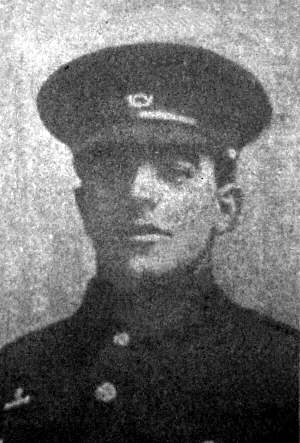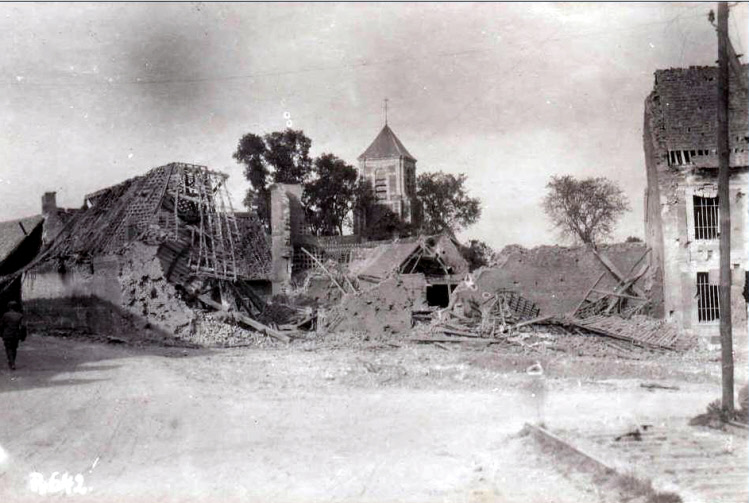 Lance-Corporal Willie Smith, 200683, King's Own Yorkshire Light Infantry, 2nd/4th Battalion
Lance-Corporal Willie Smith, 200683, King's Own Yorkshire Light Infantry, 2nd/4th Battalion
Willie Smith was born in Ossett in late 1889, the second child and second son of James Smith and his wife Sarah who married in 1887. The couple recorded that they had six children from their marriage, but one child had died before April 1911. Sarah was born in Hanging Heaton and the rest of the family were Ossett born.
Between 1891 and 1911, James Smith, a miner, latterly at Crigglestone Colliery, his wife Sarah, and their children were living in a two-roomed house on Briggs Old Row, Storrs Hill Road, Ossett. In 1911, Willie Smith, now aged 21, was working as a miner like his father and his elder brother, Fred.
Willie Smith’s army service record has not survived, but it is known that he enlisted in Ossett and joined the 2nd/4th Battalion of the King’s Own Yorkshire Light Infantry with the service number 200683. He was killed in action on 13th March 1917 and was posthumously awarded the British and Victory medals, but not the 1914/15 Star, indicating that he did not serve overseas before the 31st December 1915.
The 2nd/4th Battalion of the King's Own Yorkshire Light Infantry was formed at Wakefield on the 30th September 1914 as a second line unit. On the 1st March 1915 they moved to Bulwell and were attached to 187th Brigade in 62nd (2nd West Riding) Division. The Battalion moved in April 1915 to Strensall, York and on in May moved to Beverley, going on in November to Gateshead, in January 1916 to Larkhill and then in June 1916 to Flixton Park near Bungay. They moved again in October 1916 to Wellingborough and landed at Le Havre on the 15th January 1917.
Lance-Corporal Willie Smith was killed on the 13th March during the occupation of the village of Miraumont, which in March 1917 was a very dangerous place to be:
March 1917: Miraumont ”The Unhealthy Spot" Between the 1st and the 13th March 1917, the enemy's shell-fire took heavy toll of all units. Hostile artillery and machine-gun fire at Miraumont and the persistent efforts of snipers had claimed no less than fifteen officers and 400 other ranks, killed, wounded and missing, the loss in officers being especially serious: sickness claimed many more. Of all the unhealthy spots behind the front line (and there were many) Miraumont was the worst. At this period the village had been most entirely demolished, but had not yet quite disappeared - a few walls and ruins standing to mark the site of a once charming Picardy village. There was only one road which ran up from Beaucourt, and this the enemy shelled heavily and intermittently, so that death or mutilation haunted those who lingered in the vicinity. In a sunken road an Infantry Brigade had its Headquarters, whilst not far off the commanding officers of three Battalions lived in precarious shelters. All that was alive in Miraumont lived underground: in deep cellars and dug-outs. Almost unceasingly in one part or another of the skeleton village, shells scream and crash, raking the streets with bullets and splinters and hurling bricks and beams in every direction. Here are to be found Swain's, Foot's, Bigg's, Arnold Forster's, Hudson's and Robinson's batteries, the others being outside in the scarcely less dangerous outskirts of the village. The gunners alone in Miraumont lost six officers and seventy other ranks, whilst nine guns were knocked out of action, and many horses and mules killed. Casualties were also suffered from enemy booby-traps." 1
The "Ossett Observer" 2 had this obituary for Willie Smith:
"South Ossett Soldier Killed - A Favourite With All - A well-known South Ossett soldier, Lance-Corporal Willie Smith, of the King's Own Yorkshire Light Infantry, whose parents reside at 5, Briggs' Old-row, Storrs-hill-road, is numbered among the killed in recent fighting on the Western Front.
Enlisting in October, 1914, he had trained in various parts of the country until January of this year, when he went with his regiment to France. Of an amiable disposition, he had many friends, and his death is deeply deplored. Previous to joining the army he worked at the Hartley Bank and Crigglestone Collieries. He was 27 years of age and unmarried.
The sad news of his death was conveyed to his parents in a letter from Colonel Hind, in which the officer said: 'I deeply regret to inform you of the death of your son, Lance-Corporal W. Smith. He was killed in the advance on the 14th, and buried on the field of battle. He was a great favourite with all. During some time he helped in the officers' mess, and was always cheery and bright. We all feel his death very much, but I am sure that it will, in time, be a consolation to you to feel that he died a brave and gallant English soldier, fighting for his country'.

Above: The wrecked French village of Miraumont after being shelled during WW1.
Further confirmation of the casualty has been received from a comrade of the deceased, Private Arthur Laycock, of Horbury-road, South Ossett who, writing home this week, said that the soldier's death was caused by shrapnel and was instantaneous and that he suffered no pain."
Lance-Corporal Willie Smith, aged 28 years, son of James and Sarah Smith, of 5, Brigg's Old Row, Ossett, died on the 13th March 1917. He is remembered on Pier and Face 11C and 12A at the Thiepval Memorial,3 Somme, France. The Thiepval Memorial will be found on the D73, next to the village of Thiepval, off the main Bapaume to Albert road (D929).
On 1 July 1916, supported by a French attack to the south, thirteen divisions of Commonwealth forces launched an offensive on a line from north of Gommecourt to Maricourt. Despite a preliminary bombardment lasting seven days, the German defences were barely touched and the attack met unexpectedly fierce resistance. Losses were catastrophic and with only minimal advances on the southern flank, the initial attack was a failure. In the following weeks, huge resources of manpower and equipment were deployed in an attempt to exploit the modest successes of the first day. However, the German Army resisted tenaciously and repeated attacks and counter attacks meant a major battle for every village, copse and farmhouse gained. At the end of September, Thiepval was finally captured. The village had been an original objective of 1 July. Attacks north and east continued throughout October and into November in increasingly difficult weather conditions. The Battle of the Somme finally ended on 18 November with the onset of winter.
In the spring of 1917, the German forces fell back to their newly prepared defences, the Hindenburg Line, and there were no further significant engagements in the Somme sector until the Germans mounted their major offensive in March 1918.
The Thiepval Memorial, the Memorial to the Missing of the Somme, bears the names of more than 72,000 officers and men of the United Kingdom and South African forces who died in the Somme sector before 20 March 1918 and have no known grave. Over 90% of those commemorated died between July and November 1916. The memorial also serves as an Anglo-French Battle Memorial in recognition of the joint nature of the 1916 offensive and a small cemetery containing equal numbers of Commonwealth and French graves lies at the foot of the memorial.
The memorial, designed by Sir Edwin Lutyens, was built between 1928 and 1932 and unveiled by the Prince of Wales, in the presence of the President of France, on 1 August 1932 (originally scheduled for 16 May but due to the death of French President Doumer the ceremony was postponed until August).
The dead of other Commonwealth countries, who died on the Somme and have no known graves, are commemorated on national memorials elsewhere.
References:
1. "The History of the 62nd (West Riding) Division: 1914 - 1919" by Everard Wyrall, first published in 1924/25
2. "Ossett Observer", 17th March 1917